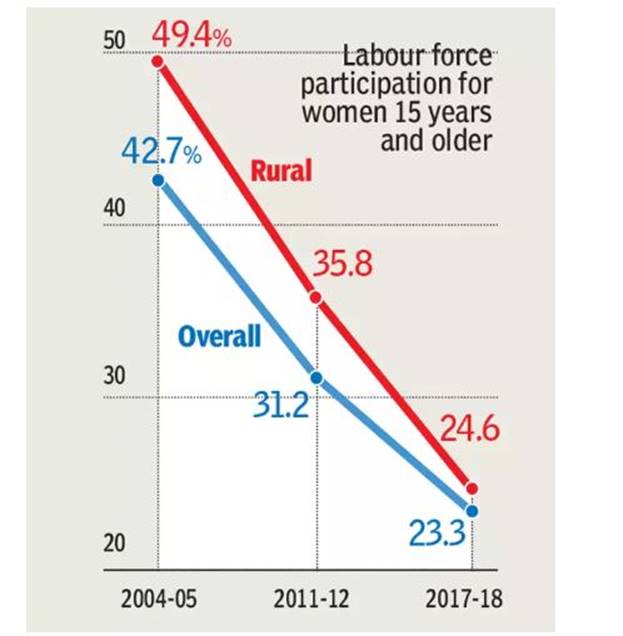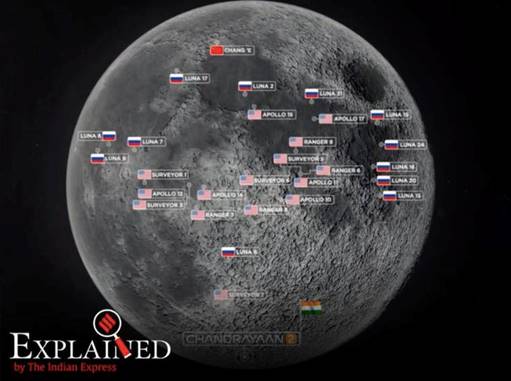



The latest periodic labour force survey of 2017-18 shows that only about 23% of working-age women are employed, down from 31% in 2011-12 and 43% in 2004-05.
Studies show that women are dropping out at all levels of education, age and income, but it is working-age rural women who have retreated dramatically — from 49% in 2004-05 to 36% in 2011-12 and now 25% in 2017-18.

- Increased education among girls have set higher expectations from the job. With economy not doing good, this expectation is not getting fulfilled.
- Double Whammy: Women are expected to undertake the work pressure as well do the household chores. It has led to double whammy and women opting out of the work.
- Poor public infrastructure like unavailability of street lights, lack of public transport also creates issues of working.
- Societal norms of restricted migration for work, having fixed time job is also keeping them out of the workforce.
- Acts like Maternal benefit which puts additional financial burden on companies creates an disincentive to hire the women work force.
- Mechanization of agriculture, fewer opportunities in construction and manufacturing sector also keeps them out of workforce.
Reference : https://timesofindia.indiatimes.com/india/where-have-all-the-working-women-gone/articleshow/70969192.cms?from=mdr&utm_source=nl_landingpage&utm_medium=web&utm_campaign=timestop10_daily_newsletter
Followers of social reformer Periyar E V Ramaswamy and members of the Dravidar Kazhagam (DK) have a fundamental right to disagree with the existence of God and religion, just as others have the right to express their views on these issues, the Madras HC ruled.
- Under article 19 of the constitution people have right to disagree with the existence of God and religion.
- Periyar had advocated atheism and self-respect.
- Periyar had declared that there is no god, god doesn’t exist and one who has created is fool.
- Why cant the state grant a citizen the status of an atheist. Recently, a man petition to convert to atheism from Hinduism was rejected in Gujarat.
- In India, population with no religion grew by four fold from census 2001 to census 2011.
- More rural people than urban people are opting for no religion.
- Identity with no religion category people remain in grey area.
- A judge in Thane court had observed that a person can be no religion practising, but cant be given identity of no religion as it complicates matter of heir and property after death of individual.
Reference: https://timesofindia.indiatimes.com/city/chennai/periyar-e-v-ramaswamys-followers-have-right-to-question-existence-of-god-madras-hc/articleshow/71001704.cms?utm_source=nl_landingpage&utm_medium=web&utm_campaign=timestop10_daily_newsletter
The Supreme Court on Friday sought a response from the Centre on petitions challenging the constitutional validity of the amendments made in the UAPA.
- It violates article 14( Right to equality), article 19 ( right to freedom ) and article 21 (right to life).
- Tagging someone terrorist without even the trial is violation of right to reputation.
- Individual is not being given an opportunity to be heard which violates principle of natural justice.
- It is unreasonable, unjust, unfair, excessive, disproportionate and violated the due process.
- A person who is designated a terrorist, even if he is de-notified subsequently, faces a lifelong stigma and this tarnishes his reputation for life.
- Designating a person as a terrorist on a mere belief of the government is arbitrary and excessive.
- It is unclear as to what legitimate aim does the state seek to achieve by declaring a person as a terrorist without even providing an efficacious remedy to challenge his notification.
Recently government has amended UAPA act. Government has recently declared Jaish-e-Mohammed chief Masood Azhar, Lashkar-e-Taiba founder Hafiz Muhammad Saeed, 1993 Mumbai blasts mastermind Dawood Ibrahim and 26/11 terror attack accused Zaki-ur-Rehman-Lakhvi individual terrorists.
- law empower the Centre to label individuals as terrorists (there used to be terrorist organisations so far and individuals were prosecuted for being part of or assisting them).
- The onus of proving that one is not a terrorist is on the individual.
- The law doesn’t specify the process that the Centre will follow to brand someone a terrorist.
- To be denotified as a ‘terrorist’, an individual can make an application to the Centre seeking a review. If his application is rejected, the individual can approach a review committee. If the committee rules in his favour, the terrorist tag is taken away.
- There’s no specified time limit for the appointment of a review committee or the time limit in which it is supposed to give its order.
Reference: https://timesofindia.indiatimes.com/india/sc-seeks-centres-response-on-pleas-challenging-validity-of-amendments-to-uapa/articleshow/71005363.cms?utm_source=nl_landingpage&utm_medium=web&utm_campaign=timestop10_daily_newsletter
The clinching evidence of presence of water on moon was provided by Chandrayaan-1 mission, which was launched in 2008. It has totally changed the way scientists now view the moon, and has led to a renewed interest in lunar exploration.
- Presence of water is crucial for the hopes of using moon as a future launch pad to send probes deeper in to space.
- Human beings can use moon for extended period stays which is not possible in the absence of water.
- A lot of water is believed to be present in the polar regions of the moon, trapped as ice in deep craters.
- it can be used for life support and manufacturing rocket fuel.
- Lunar surface is full of oxides of different elements. These oxides could react with hydrogen ion in the solar winds to make hydroxyl molecules, which could combine again with hydrogen to make H20.
- The water could also have come from external sources.
Reference: https://indianexpress.com/article/explained/explained-chandrayaan-2-and-the-quest-for-water-on-moon-5972598/
Explained: Why Chandrayaan-2 will land near the south pole of the Moon

The furthest that any spacecraft has gone from the equator was Surveyor 7, launched by NASA, that made a moon landing way back on January 10, 1968. This spacecraft landed near 40 degree south latitude.
- Its lander module, called Vikram, will land at a location very close to the south pole of the moon, near a latitude of about 70 degree south of lunar equator.
- It is easier and safer to land near the equator.
- The terrain and temperature are more hospitable, and conducive for longer and sustained operation of instruments.
- The surface here is even and smooth, very steep slopes are almost absent, and there are fewer hills or craters.
- Sunlight is present in abundance, at least on the side facing the earth, thus offering regular supply of energy to solar-powered instruments.
- The polar regions of the moon, however, are a very different, and difficult, terrain.
- Many parts lie in a completely dark region where sunlight never reaches, and temperatures can go below 230 degree Celsius.
- Lack of sunlight and extreme low temperatures create difficulty in operation of instruments.
- There are large craters all over the place, ranging from a few cm in size to those extending to several thousands of kilometres.
- As a result, the polar regions of the moon have remained unexplored.
- There are indications of presence of ice molecules in substantial amounts in the deep craters in this region.
- The extremely cold temperatures here mean that anything trapped here would remain frozen in time, without undergoing much change. The rocks and soil in this region could therefore provide clues to early solar system.
Therefore, there is an immense potential to reveal new science through the exploration of polar regions of the moon.
Chandrayaan-2 was originally scheduled to be launched way back in 2011 itself, immediately after Chandrayaan-1 which was launched in 2008 and remained functional in its orbit till about a year later.
- Chandrayaan-2 was supposed to be a joint collaborative mission between India and Russia.
- While the Indian Space Research Organisation (ISRO) was to provide the rocket and the Orbiter module, the lander and rover modules were to come from Russia’s Roscosmos space agency.
- ISRO did not have the capability to build its own lander and rover at that time.
- The kind of lander and rover that Russia was preparing to send on Chandrayaan-2, however, developed problem on a different mission.
- The new proposed design was found to be incompatible to Chandrayaan-2.
- Russia had to eventually pull itself out from the collaboration, which left ISRO to make efforts to develop its own lander and rover through research and development.
- This delay also provided ISRO additional time to improve on the design of the main spacecraft.
Reference: https://indianexpress.com/article/explained/explained-chandrayaan-2-was-to-be-launched-by-india-and-russia-in-2011-its-delayed-but-better-5972440/
India’s hopes of becoming the first nation to touch down on the Moon’s South Polar region seems to have ended in disappointment as it lost contact with the Vikram lander of Chandrayaan-2, moments before the historic touchdown on Saturday.
- Chandrayaan-1 had also sent a vehicle to the lunar South Pole, though that spacecraft crash landed into the ground, in November 2008, rather than land intact.
- Sivan had earlier described Chandrayaan 2 as the “most complex mission ever undertaken by ISRO” and said that the prospect of the landers’ 15 minute descent — navigating its way autonomously — as “terrifying”.
- Out Of the 38 previous attempts of 'soft landing' on the lunar surface so far, only 20 have been successful.
- But all is not lost. More than half of the scientific instruments it carried to the Moon are safe on the orbiter, which continues to hover around 100 km above the Moon.
- It will spend the next year mapping the lunar surface and studying the deposits of water ice at the South Pole.
Reference: https://timesofindia.indiatimes.com/india/isro-loses-contact-with-vikram-when-it-was-just-2km-from-lunar-surface/articleshow/71018212.cms?utm_source=nl_landingpage&utm_medium=web&utm_campaign=timestop10_daily_newsletter

© 2025 iasgyan. All right reserved